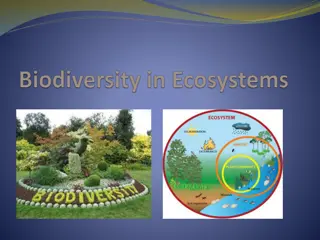Understanding Natural Selection in Ecosystems: Post-Test Insights
Explore concepts of natural selection in ecosystems through intriguing questions about sharks, clownfish, American black bears, and Galapagos finches. Test your knowledge on heredity and the benefits of sexual reproduction. Gain insights into adaptations, variations, and evolutionary processes in different species.
Download Presentation

Please find below an Image/Link to download the presentation.
The content on the website is provided AS IS for your information and personal use only. It may not be sold, licensed, or shared on other websites without obtaining consent from the author. Download presentation by click this link. If you encounter any issues during the download, it is possible that the publisher has removed the file from their server.
E N D
Presentation Transcript
Life Science- Ecosystems: Natural Selection Post-Test
1. Sharks and Clown Fish live in the same biome, but have very different body types. Why is this? A. Clown fish are venomous B. Sharks and clown fish are both predators C. Sharks and clown fish occupy different niches within the same ecosystem. D. Sharks and clown fish are competitors for the same food sources
2. Despite their name, the American Black Bear can come in a variety of colors. The frequency of this variety is related to where they live. In western states with mountain meadows and open sunlit forests, many bears are brown to blonde. In states east of the great plains where forests are dense and brushy almost all of the Black Bears are indeed black.What is a possible explanation for this variation? A. Random mutations B. The fur on the lighter bears serves as a warning to predators and the black fur serves as camouflage C. Western states get more snow and the lighter fur helps them blend in D. Western states are warmer and having lighter fur reduces heat stress and black fur is more resistant to the rougher plants and terrain in the east
3. The many species of finches found on the Galapagos Islands all evolved from a common ancestor. The best explanation for the variety in beak shape and size (seen above) between species is: A. The common ancestor bred with other species of birds that had different beaks, leading to hybrid species with different traits B. Mutations that affected beak shape and size in the common ancestor allowed certain finches to occupy new niches and access new food supplies, increasing survival and passing on of those traits C. A virus infected parts of the ancestral population and inserted plasmid DNA into their chromosomes which was passed down to subsequent generations D. Birds in the ancestral population carved their beaks into different shapes depending on what food they ate
4. Which of these is the best definition of heredity: A. The mixture of parental traits seen in the offspring of asexual reproduction B. The passing down of genetic instructions in the form of DNA from one generation to the next C. The passing down of DNA in the form of chromosomes from parent to offspring in eukaryotic organisms D. The splitting of the cell membrane that contains unique proteins during cell division
Which of the following best describes a benefit of sexual reproduction over asexual reproduction? A. Sexual reproduction results in more genetic variability which allows organisms to differentiate and occupy different niches B. Asexual reproduction results in a more diverse population C. The lack of diversity in sexually reproducing populations decreases survival D. Because offspring of asexual reproduction are identical to their parent, they are more likely to survive























